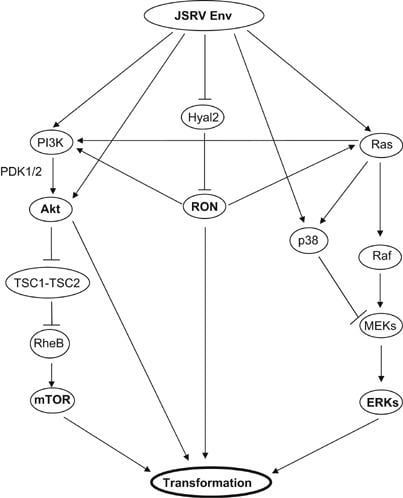Group Group VI (ssRNA-RT) Family Retroviridae Genus Betaretrovirus Rank Species | Order Unassigned Higher classification Betaretrovirus | |
 | ||
Scientific name Jaagsiekte sheep retrovirus Similar Retrovirus, Mouse mammary tumor virus, Murine leukemia virus, Simian retrovirus, Gammaretrovirus | ||
Jaagsiekte sheep retrovirus (JSRV) is a betaretrovirus which is the causative agent of a contagious lung cancer in sheep, called ovine pulmonary adenocarcinoma.
Contents
- Medical vocabulary what does jaagsiekte sheep retrovirus mean
- Natural history
- Classification
- Pathogenesis
- Genome structure
- Replication cycle
- Receptor and entry
- Host immune response
- References
Medical vocabulary what does jaagsiekte sheep retrovirus mean
Natural history
JSRV is the virus that is the etiologic agent responsible for contagious lung tumors in sheep called ovine pulmonary adenocarcinoma (OPA). The disease has also been called “jaagsiekte”, after the Afrikaans words for “chase” (jaag) and “sickness” (siekte), to describe the respiratory distress observed in an animal out of breath from being chased, indicating the breathing difficulty experienced by infected sheep. Transmission of virus is through aerosol spread between sheep.
The exogenous infectious form of JSRV has an endogenous counterpart which is present in the genomes of all sheep and goats. The sheep genome has around 27 copies of endogenous retroviruses (enJSRVs) that are closely related to JSRV. Endogenous JSRV has several roles in the evolution of the domestic sheep as they are able to block the JSRV replication cycle and play a critical role in sheep conceptus development and placental morphogenesis.
Although OPA resembles human lung cancer, human lung cancer is not known to be caused by betaretroviruses. Even though a possibility of viral etiology has been eliminated in bronchoalveolar cancer, understanding the molecular mechanisms leading to the transformation of lung epithelia by JSRV may be of interest in the context of therapeutic approaches in human lung cancers in general and bronchoalveolar adenocarcinoma (BAC) in particular.
Classification
JSRV belongs to the family Retroviridae, to the subfamily Orthoretrovirinae and the genus Betaretrovirus.
Pathogenesis
JSRV is transmitted by the respiratory route and may also infect lymphocytes and myeloid cells, in addition to the lung epithelia. Expression of the JSRV Envelope protein activates signalling cascades that promote cellular proliferation and malignant transformation of the cells. Initially, the tumour cells grow along the alveolar walls in a pattern reminiscent of human BAC, but subsequently become more invasive and metastasize to the local lymph nodes. Larger tumours may be necrotic and fibromatous at their centre. As the tumour grows, fluid production in the lung increases and this is likely to promote virus spread to other sheep. Only when the tumour reaches a size large enough to compromise lung function, do clinical signs appear. Critically, the majority of infected animals in endemic areas never show outward signs of infection, but they may be shedding virus, thus promoting inadvertent introduction of the disease into previously unaffected flocks and new geographical areas.
Genome structure
The genome of the exogenous virus is 7462 bases and has the classical "gag", "pol", "env" genome arrangement and is flanked by a long terminal repeat (LTR) on each end. There are 4 genes that encode the viral structural proteins. They are "gag" encoding the structural internal virion proteins comprising "matrix" (MA), "capsid" (CA) and "nucleocapsid"(NC); "pro", which encodes an aspartic protease (PR); "pol", which encodes the" RT" and "integrase"(IN) enzymes; and "env", which encodes the "surface" (SU) and "transmembrane "(TM) envelope glycoproteins. The viral proteins are synthesized initially as large precursors and are later processed into the mature proteins by proteolytic cleavage. An additional open reading frame (ORF) was observed in the viral genome and has been called orfX and its function is undefined.
Replication cycle
The initial attachment of JSRV to its target cell is mediated through the binding of the SU subunit of the Env glycoprotein to a specific cell surface receptor molecule,"Hyal2". The entry of the JSRV core into the cytoplasm activates reverse transcription, during which the single-stranded RNA genome is converted into a double-stranded DNA form and gets integrated as a provirus into the host. Following integration, expression of JSRV RNA from the viral promoter in the LTR is controlled by the host transcriptional machine. Following transcription and translation of the viral genome, the new progeny virus gets assembled at the plasma membrane and bud off from the host cell acquiring a lipid envelope and their "env" glycoproteins. Following release from the cell, the "Gag"-"Pro"-"Pol" polyproteins are cleaved into their mature forms by Protease. This step maturation is essential for the formation of infectious particles.
Receptor and entry
The cellular receptor for JSRV is hyaluronidase 2 (Hyal2), a glycophosphatidylinol(GPI)-anchored protein belonging to the hyaluronidase family. Generally, oncogenic retroviruses cause transformation of host cells mostly by insertional activation of a host proto oncogene into an oncogene. But JSRV is different in this aspect since its envelope glycoprotein ("env") by itself is an oncogene and this single protein was shown to be necessary and sufficient to induce lung tumors in sheep. Unlike the majority of retroviruses, JSRV entry into the host cell is pH-dependent. Thus oncogenic JSRV has borrowed features of both pH-dependent and pH-independent viruses for entry which involves both the receptor binding and a low pH for fusion transformation of host cells.
Host immune response
An important feature of JSRV infection is the absence of any specific immune response from the host. A likely explanation is that the sheep are immunologically tolerant to JSRV antigens due to the expression of closely related endogenous JSRV proteins in the fetal thymus during T lymphocyte development and any JSRV-reactive T cells should be recognized as ‘anti-self’ and selectively removed. Another hypothesis is that tumor cells downregulate their major histocompatibility class-I expression, possibly being the reason for the absence of any virus-specific cytotoxic T cell response (CTL).
